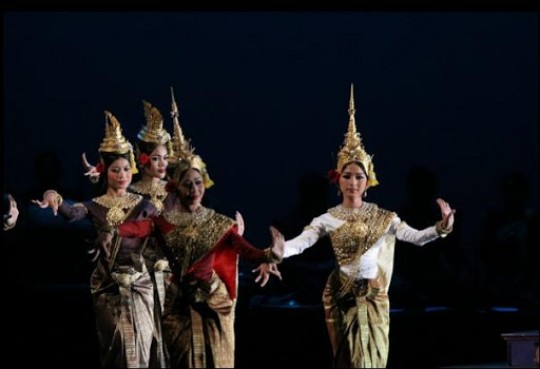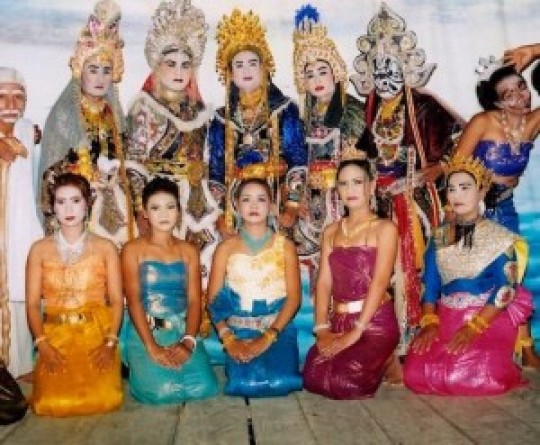Lakhaon Poul Srei (Female Masked Theatre)
Lakhaon Poul Srei is the female version of Lakhaon Khaol (classical male masked theater), which literally translates as 'female narration'. Both forms combine classical theater and dance and are accompanied by the traditional pin peat orchestra. Unlike Lakhaon Khaol, which uses a separate group of narrators, Lakhaon Poul Srei dancers take turns narrating while other members continue to dance. The dancers often lift their masks and narrate directly to the audience.

Cambodian dance (Khmer: "Robam") is divided into royal court classical dance, folk dance, and social/popular/contemporary dance.
Khmer classical dance, also known as "Robam Preah Reach Trop," is Cambodia's main performing art form. It is a visually stunning dance style that originated in the royal courts.
Originally performed and preserved by royal palace attendees, Khmer classical dance was presented to the wider population in the mid-20th century and then became widely appreciated as iconic in the Cambodian cultural context, often played during public gatherings, vacations, and for international visitors to Cambodia.
Exquisitely clothed dancers execute slow and expressive motions to the background music of a Pinpeat group. Traditional legends and epic poetry, such as the Ramayana, are enacted in the classical repertory, as are dances of homage or invocation.
Khmer classical dance is also known as "Cambodian court dance" and "Cambodian royal ballet," but the latter title can also apply to the National Dance Company of Cambodia.
In Khmer, it is technically called Robam Preah Reach Trop (royal wealth dances) or Lakhon Preah Reach Trop (royal wealth dances) (Theatre of royal wealth). It is also known as Lakhon Luong (the King's Theatre).
During Cambodia's Lon Nol government, the dance genre was known as Lakhon Kbach Boran Khmer (Khmer Theatre of the ancient style), which removed it from its royal heritage.
What Is Lakhaon Poul Srei?
Poul Srey is a form of Khmer Theatre of the ancient style that is very similar to the art of Khmer classical dance, including musical performances, costumes, and performers. But what makes this dance unique is all the performers are females despite the male characters.
All the characters have to talk, sing, and dance during the performance. The legacy states that "Poul Srey" is a descendant of Preah Reach Trop. This form of play has one teacher or one person as the narrator.
How Is Lakhorn Poul Srei (Female Version of Lakhaon Khaol) Performed?
Lakhaon Poul Srei is the feminine resemblance to Lakhaon Khaol. Both styles are performed with Pin Peat music. This form of play truly depicts the story of an ingenious traditional Khmer character. However, no document has been able to confirm the birth, origin, or evolution of this play. Some unofficial sources revealed that it may have originated in four different reigns.
But if we look at the way they perform, we see a big difference between the form of traditional Theatre and Khmer royal Theatre. The reason is traditional Khmer Theatre has all the female characters who show only gentle and luxurious gestures according to the group's songs. Besides, the dancers do not speak or sing themselves.
Lakhaon Poul Srey, on the other hand, is based on the Khmer traditional drama or the royal drama. Meanwhile, both male and female characters have to dance and sing by themselves. The technical term in this form is often called "Sing By Yourself, Dance By Yourself."
The characters who wear face masks like giants, hermits, monkeys, etc. When they need to speak, they have to open their face masks, pull them over a bit, and speak. In this way, we see the authenticity of the giant art form, performing ancient legends and myths. Male artists can only play the role of comedians and other animal characters, such as horses.
When And Where Did Lakhaon Poul Srei Come From?
According to the 2003 edition of Khmer Spectacles, there is no clear source to confirm this female opera form's origin, date of birth, and evolution.
However, we can see that this play art is only available in some districts of Kandal province, such as the Kien Svay and Khsach Kandal districts. At the same time, many researchers temporarily conclude that this female opera is the royal property's offspring.
The Possible Creations of Female Masked Theatre
The female mask dance Theatre may have been born in four different reigns.
Firstly, the dance could occur during the "Longvek" period, especially during the reign of Ang Chan I or Chan Reachea (Khmer: ចន្ទរាជា). He was the Cambodian king who reigned from 1516 to 1566. He was viewed as one of the most distinguished Cambodian kings of the post-Angkor era. Many types of research show that he was the most prestigious and honorable king in the history of Cambodia. The king reigned with great splendor. He collected and refined all the scholars, royal scholars, the worldly, the moral, the monks, the laity, the scriptures, and all the documents as the kingdom's foundation. Moreover, he promoted national culture, including the practice of male Theatre, female Theatre, singing, music, and all kinds of honors.
Secondly, Poul Srey can be traced back to the reign of Srei Soriyopear (Khmer: ស្រីសុរិយោពណ៌). He sovereign Cambodia from 1603 to 1618. The king reigned at the palace of Koh Slaket (now Koh Nora), Prey Lvea Paem district, Lvea Em district, not far from Kien Svay district in Kandal province, where the female classical dance is located today.
Thirdly, the female puppet form can be traced back to the reign of Thommo Reachea II or Ponhea To (Khmer: ពញាតូ) who reigned Cambodia from 1628 to 1631. The king was very interested in literature. Initially, he resided in the capital of Udong. Then he left the capital of Udong to locate in the palace of Koh Khlok (now called Koh Oknha Tey, Khsach Kandal district) to complete his literary exertion. He may have brought this female dance form with him, leaving the earthly affairs to his uncle as the ruler to stay in Udong to oversee the work for him instead. Apparently, that's when the dance instructor from Koh Khlok Palace continued to teach the classical female-group dance in Kien Svay, which we still see today.
Fourthly, this female classical dance form can be sketched back to Queen Ang Mey. Ang Mey (Khmer: អង្គម៉ី) was a monarch of Cambodia. Crowned on the Cambodian throne by the Vietnamese, her reign prevailed during the Siamese-Vietnamese War (1841–1845). The queen resided in the palace of Koh Slaket near the Kien Svay district in Kandal province.
In addition, according a book on the intangible cultural heritage of the Ministry of Culture and Fine Arts, published in 2017 on page 121, it is stated that in 1878, an artist named Jin, a master Theatre teacher from Tycoon Island, went to teach martial arts. Poul Srey Theatre at Wat Kien Svay Krao, Kandal Province.
Today, his closest student, 70-year-old Chea Muth, a female actress at the time, is re-teaching the play at Wat Kien Svay Krao after more than 40 years off.
The female drama "Chey Sen" by Wat Kien Svay Krao was performed at Chaktomuk Hall on July 2, 1999, with the support of the Ministry of Culture and Fine Arts and UNESCO.






